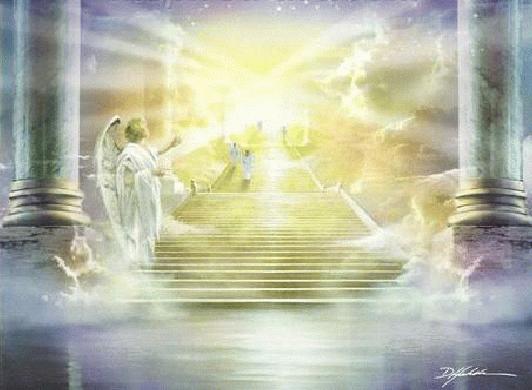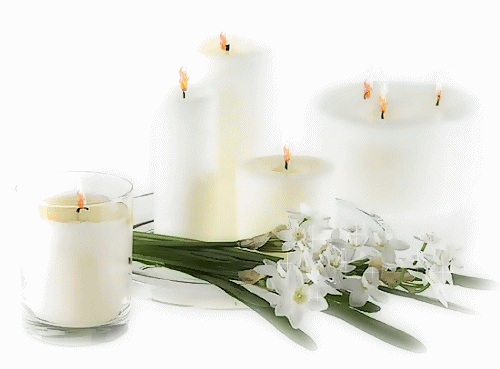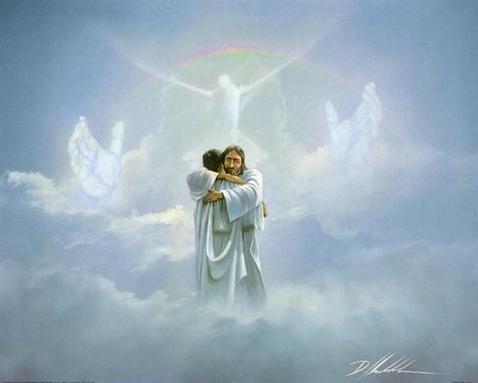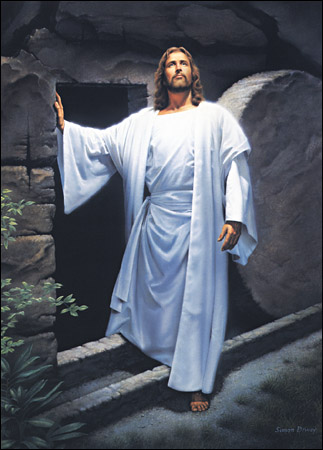
TRUE MEANING OF EASTER SUNDAY
Transliterated by: "Michael AngelOh"
easter sunday holyweek calendar of events navigation station

I have always been interested in the various ways in which people choose to celebrate holidays. The special things people think, say, and do personally and collectively seem to make a statement about the overall perspective and quality of life that have always given meaning to the journey of life for me. This is why I so appreciate all holidays not only because we get time off from work and our usual schedule of activity but because we have an opportunity to create and express what we care about and who we care about. "Easter Sunday" is a holiday that helps me and I hope many others to enhance and celebrate the true meaning of existance and living life on purpose.
I will personally celebrate Easter with my family as an observance of Christ's resurrection and his conquest over death. Someone else may honor this holiday as the first Sunday of Spring or the start of planting season or just a wonderful opportunity to be with family and friends. I'll attend an "Easter Service" and celebrate the Spirit of the resurrection but one of the most important ways I celebrate any this and any holiday is to simply show as much care and kindness to others as I know how. I invite you to join me this Palm and upcomming Easter Sunday in celebrating whatever your beliefs or preferances may be and I wholeheartedly wish each of you safe and golden moments and memories.
Our Easter Sunday offering presents some of the historical origins and holiday traditions for the holiday we call "Easter" in the forms of the holidays historical record, images, music and prose. I hope you will find this humble offering to be informative, enlightening and inspiring in the way you choose to celebrate the meaning of Easter for you.

click on image above to expand
THE RESURRECTION OF JESUS CHRIST
Transliterated by: "Michael AngelOh"
easter sunday holyweek calendar of events navigation station

For many around the world, "Easter" represents the celebration of "Jesus Christ's" return to life after his crucifixion on the cross by the Romans. Christ's return from death known as the "Resurrection" is recorded in the holy scriptures of the Bible. His followers, the apostles and others are also recorded to have seen and spoken to Christ for a 40-day period following his resurrection until the day of his "Ascension" into the heavens. Christians therefore believe that they too can receive new life after death through faith in Christ's miracle of the resurrection and Easter is the celebration of this belief.
In 325 AD, the council of "Nicea" issued an edict that read, in pertinent part, "Easter was to fall upon the first Sunday after the first full moon on or after the Vernal Equinox and if said full moon fell on a Sunday, then Easter should be celebrated on the Sunday after..." The direct relationship to Sunday as the day sacred to the Sun, the ultimate symbol of life, is obvious yet the subtle connections to the earlier celebrations of the time of planting and the Moon are of equal importance in determining the day of the Easter celebration. Easter can occur on any Sunday between March 22nd and April 25th. It is one of the most sacred of all the Christian holidays.

click on image above to expand
EASTER HISTORY, REASON FOR THE SEASON
Transliterated by: "Michael AngelOh"
easter sunday holyweek calendar of events navigation station

Long before Easter became the holiday it is today, the Spring festival
was celebrated by people around the world. Although associated with the Sun and the Vernal Equinox, this celebration was originally based on the lunar calendar. The name Easter is derived from the Saxon word "Eostre" which is synonymous with the name of the Phoenician Goddess of the Moon, "Astarte", a Germanic goddess of Spring and the deity who measured time. The Jewish festival called "Purim", also celebrated in the Spring, has as it's central character and heroine, "Esther". Even the word moon is derived from the Sanskrit word "Mas" or "Ma", meaning "to measure." Many scholars have suggested that the reason the moon was chosen by the ancients as the way to measure time was the link between the female cycle and the cycle of the moon. A lunar month of 28 days gave 13 periods in 364 days, which was the solar equivalent of 52 weeks. The ancient Hebrews had long followed a lunar calendar, as had most other ancient cultures thus humans could match their natural lives with the celestial nature of the night sky above them.
As Christianity grew and spread throughout the world, it was a common practice to adopt, modify, convert or take over existing non-Christian festivals, sacred locations and even names, and assimilate them into the Christian theology. The Romans used this method of cultural absorption for centuries as a way of expanding and firming up the Empire. Given the fact that Christianity developed it's roots during the time of the Roman empire, it is not surprising that the same technique was used to spread the belief in Christ. A good example of this was in ancient Britain where the bearers of the Cross built their churches and monasteries on the very sites where far more ancient rites had been held previously. Because Eostre, also know as Ostara, was the goddess of Spring and her symbolism dealt with renewal and rebirth, the Christian belief in the resurrection of Christ fit well into these pre-existing themes.

THE MEANING OF LENT
Transliterated by: "Michael AngelOh"
easter sunday holyweek calendar of events navigation station

"Lent", also called the "Lenten Season", is the forty day period before Easter when Christians have traditionally mourned their sins in preparation for the celebration of Easter. Lent always begins on "Ash Wednesday" which is usually the second Wednesday of February. The season of Lent is 40 days long excluding Sundays. The number 40 is the Biblical number for a time of preparation and cleansing. It is quoted numerous times throughout Biblical scripture.
It rained for 40 days and nights during the flood while God cleansed the world.
The children of Israel wandered in the desert for 40 years while God cleansed them of their rebellion.
Christ fasted for 40 days to prepare for his ministry as he was tempted by Satan in the wilderness who offerred him all the worlds kingdoms if he would bow before him in honor.
The reason Sundays are excluded when counting these 40 days is that each Sunday is a celebration of the day of the week on which Christ rose. So each Sunday is to be honored as a kind of surrogate Easter Sunday as a reminder fo the day Christ was resurrected.
Lent is a season of prayer and fasting during which we remember our fallen or sinful condition and recognize our need for a Savior to die for our sins and rise to offer us new life. In the church we make use of crosses or crucifixes and the color purple to represent Christ's death on the cross. The purple represents the bruises Christ suffered for our sins. Some Christians celebrate Lent in their personal devotional lives by giving up negative habits or unhealthy or unclean foods. Others set aside extra time for prayer and Scriptural Studies.
"And the Spirit immediately drove Jesus out into the wilderness. He was in the wilderness forty days, tempted by Satan; and he was with the wild beasts; and angels waited on him..." (Mark 1:12-13)

EASTER TRADITIONS
Transliterated by: "Michael AngelOh"
easter sunday holyweek calendar of events navigation station

The cross and the lily are both Christian symbols relating to the religious significance of the season and the renewal of faith. Similarly, the lamb has a religious basis, both in Christianity (Christ as the Good Shepherd) and in Judaism (the Paschal Lamb). The view of a lamb as a symbol of new life is the foundation for both religious images. The "Easter Bonnet" and the wearing of new clothes on Easter Sunday are fairly recent additions to Easter traditions. While imitating the more ancient view that new clothes and colors symbolized the end of Winter and the beginning of new life and renewal, the actual practice of strolling to Church in your "Sunday Best" was not prevalent until the end of the nineteenth century. Easter, though identified in modern times as the Christian Holy Day on which Jesus Christ conquered death through his glorious resurrection, also reminds us of the ancient celebration of Spring, and that there is always a chance to plant our dreams anew. That our cold Winters will pass and that in the course of humankind, we can always replant and start over again...

CHRISTIAN EASTER SYMBOLS
Transliterated by: "Michael AngelOh"
easter sunday holyweek calendar of events navigation station

Easter traditions and symbols are abundant but understanding the origins of our modern day Easter Sunday celebration will hopefully shed greater light upon the holyday that sees images of bunnies, eggs and the resurrection of no ordinary man. To many people, Easter marks a time of miracles, new beginnings and the reaffirming of faith. To those with a more secular view of the world, it is a celebration of the end of Winter and a time to look forward to the warmth of the coming Summer. It also represents an opportunity to shed the heavy clothing of Winter for the bright colors of Spring. Easter traditions and symbols are well known as the Easter Bunny, Easter Eggs and Easter Baskets yet there is more to these images than meets the eye.

WHERE DID THE EASTER BUNNY COME FROM
Transliterated by: "Michael AngelOh"
easter sunday holyweek calendar of events navigation station

Of all the symbols of Easter, the "Easter Bunny" seems to have endured along with its floppy-eared chocolate confection counterpart. The first documented use of the bunny as a symbol of Easter appears in Germany in the 1500's, although the actual matching of the holiday and the bunny was probably a much earlier folk tradition. Not surprisingly, it was also the Germans who made the first edible Easter Bunnies in the 1800's. The Pennsylvania Dutch brought the beneficent Easter Bunny to the United States in the 1700s'. Many Asian and Eurasian cultures revere the rabbit (or hare) as a sacred messenger of the Divine. To the Chinese, he is a creature in the moon, pounding rice (the staff of life) in a mortar. To the followers of Buddhism the rabbit was placed in the moon as a result of his self-sacrifice in offering himself as food. To the Egyptians, the hare (as opposed to the rabbit) was known as "Un", which meant "to open," or "the opener." This was because the hare, unlike his cotton-tailed cousin, is born with his eyes open. "Un" also meant "period" as it was a symbol for both lunar and human cycles. This also blended well with Celtic tradition, which viewed the hare as a symbol of fertility and new life. The Germanic tradition taught that the "hare" brought new life each Spring. To the Native American peoples, he was the Trickster-Transformer who either plays the Fool or, in other instances, has brought about a benefit for humankind (i.e., the legend of rabbit bringing fire to the people). The ancient Mayan culture gives the rabbit credit for inventing Mayan writing. Just as the ancient sacred places and names were blended into the holiday celebration we know today as Easter, so too was the rabbit- hare molded from an ancient bringer of new life and renewal into the Easter Bunny. In truth, the rabbit stays the same, a messenger of a season when all things are possible and all things can again be new.

EASTER EGGS & EASTER EGG HUNTS
Transliterated by: "Michael AngelOh"
easter sunday holyweek calendar of events navigation station

The egg, long a symbol of fertility, has been a traditional staple of Easter celebrations. The pairing of the "Easter Egg" and the "Easter Bunny" at the end of the nineteenth century was not only a stroke of marketing genius, but also well-founded in the traditions of the past. It is known that eggs were painted with bright colors to celebrate Spring and were used in Easter egg-rolling contests and given as gifts, a practice that predated the advent of Christianity. Medieval records note that eggs were often given as Easter gifts to servants by their masters. What is known is that the egg, like the rabbit, was a symbol of the renewal of life and therefore a logical symbol for the celebration of Easter. The Greeks dye their Easter Eggs red to symbolize and honor the blood of Christ. The Easter Egg hunt itself has also taken many cultural twists and turns. In America, of course, the colored Easter Eggs are hidden and then children search for them. In the northern counties of England, children act out the "Pace Egg Play" and beg for eggs and other presents. The term "Pace" itself is a derivative of the ancient Hebrew verb "Posach" meaning to "pass over" which has evolved into the better known word and holiday title Pesach, or the Jewish Passover. The Easter Egg, like the rabbit, has become fused into the Spring festival of Easter throughout the world as an image of new life and renewal.

ABOUT EASTER BASKETS
Transliterated by: "Michael AngelOh"
easter sunday holyweek calendar of events navigation station

The Easter basket originates from the ancient Catholic custom of taking the food for Easter dinner to mass to be blessed. This too, mirrored the even more ancient ritual of bringing the first crops and seedlings to the temple
to insure a good growing season. This practice, combined with the "rabbit's nest" evolved into the brightly colored containers filled with sweets, toys and the like left for children on Easter morning by that "omnipotent hare".

MEANING OF THE BELLS OF EASTER
Transliterated by: "Michael AngelOh"
easter sunday holyweek calendar of events navigation station

The custom of the use of bells at Easter comes originally from Italy. While the gentle pealing of these huge instruments can be heard throughout the year, their songs fall silent on "Holy Thursday", the Thursday before Easter and were not to be heard again until Easter Sunday morning, thus marking the resurrection. This Easter tradition too, has an older origin. In many ancient belief systems the period before an Equinox or Solstice was a time of reflection on the past seasons. This period of silence would then be marked by a joyous celebration of light and sound that told all that darkness had fled and that new life was coming back into the world.

PASSOVER THE JUDEO CHRISTIAN CONNECTION
Transliterated by: "Michael AngelOh"
easter sunday holyweek calendar of events navigation station

The Passover was referred to as "the sacrifice of the lamb" in Egypt when the people of Israel were slaves. They smeared the blood of the lamb on their doorpost as a signal to God that He should "Pass over" their houses when all the firstborn of Egypt perished in response to the Egyptian Pharoah's own proclamation. Passover officially began on the evening of the day the Israelites left Egypt. Passover also commemorated their departure from Egypt in haste and so "unleavened bread" was used in their celebrations because this showed that people had no time to put leaven in their bread as they ate their final meals as slaves in Egypt. Jesus was crucified in the city during one of these Passover celebrations. He and His disciples ate a Passover meal together on the eve of His death. Like the blood of the lamb that saved the Hebrew people from destruction in Egypt, His blood, as the ultimate Passover sacrifice, redeems believers from the power of sin and death (1 Cor. 5:7). This holiday is celebrated by Christians as "Holy Thursday", the day Christ shared the Passover meal with his Apostles popularly known today as "The Last Supper". The connection between Christ's Resurrection and the Jewish Passover, which, in addition to the dramatic story of the flight from Egypt, also contains elements of a Spring celebration, and made the merging of the two religious traditions more easily accomplished.

click on image above to expand
EASTER QUOTES, POEMS & VERSES
Transliterated by: "Michael AngelOh"
easter sunday holyweek calendar of events navigation station

"The resurrection gives my life meaning and direction and the opportunity to start over no matter what my circumstances..."
~Robert Flatt
"Easter says you can put truth in a grave, but it won't stay there..."
~Clarence W. Hall
"Celestial spirit that doth roll
The heart's sepulchral stone away,
Be this our resurrection day,
The singing Easter of the soul
O gentle Master of the Wise,
Teach us to say: "I will arise..."
~Richard Le Gallienne
"The joyful news that He is risen does not change the contemporary world. Still before us lie work, discipline, sacrifice. But the fact of Easter gives us the spiritual power to do the work, accept the discipline, and make the sacrifice..."
~Henry Knox Sherrill
"Easter is the demonstration of God that life is essentially spiritual and timeless..."
~Charles M. Crowe
"On Easter Day the veil between time and eternity thins to gossamer..."
~Douglas Horton
"Easter is not a time for groping through dusty, musty tomes or tombs to disprove spontaneous generation or even to prove life eternal. It is a day to fan the ashes of dead hope, a day to banish doubts and seek the slopes where the sun is rising, to revel in the faith which transports us out of ourselves and the dead past into the vast and inviting unknown..."
~Author unknown, as quoted in the Lewiston Tribune
"Easter spells out beauty, the rare beauty of new life..."
~S.D. Gordon
"He takes men out of time and makes them feel eternity..."
~Ralph Waldo Emerson
"Thou art the Sun of other days.
They shine by giving back the rays..."
~John Keble, The Christian Year: Easter Days
"For God so loved the world, that He gave his only begotten Son, that whosoever believeth in Him should not perish,
but have everlasting life..."
~John 3: 16~

HAPPY EASTER SUNDAY LINKS
return to easter sunday holyweek calendar of events navigation station

THE MEANING OF ASCENSION RESURRECTION SUNDAY
EASTER RESOURCES INDEX
LOCATING EASTER DATES THROUGH THE YEAR 2199
THE EASTER CHRISTIAN CALENDAR
GOD IS LOVE
BIBLE SCRIPTURES REFERANCE INDEX
THE PRAYER DIRECTORY
HAWAIIAN PHOTO GALLERY
SUN STAR PHOTOGRAPHY
|